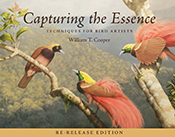Australian High Country Owls

By: Jerry Olsen
Descriptions, anecdotes and conservation issues referring to Australia's major owl species.
Australian High Country Owls provides the latest scientific information on Australian owl species, especially Ninox owls. It details studies of Southern Boobooks and Powerful Owls, visits to North America and Europe to learn about owl research, and the resulting publications that overturned some existing beliefs about Australian owls. Ultimately, this led to the discovery of a new owl species in Indonesia, the Little Sumba Hawk-Owl. + Full description
Appendices cover the biology, conservation and rehabilitation of Australian owls, including: field recognition, subspecies taxonomy, habitat, behaviour, food, range, migration, breeding, voice and calls, status and myths, questions about each species, and techniques for caring for injured and orphaned owls.
The book includes numerous photographs of different owl species, and will be a handy reference for bird researchers and amateur bird watchers alike.
2012 Whitley Award Commendation for Vertebrate Natural History.
- Short descriptionNews
No longer available in a print edition.
Reviews
"This book is a must have for anyone interested in learning more about these mysterious and amazing creatures."
Dr Raylene cooke, The Victorian Naturalist, pp. 62, 2013
"A highlight of the book is the way in which the author is able to provide both information on the biology of owls and, at a much more personal level, to take the reader into the field to experience the world of owls."
Chris Pavey, Australian Field Ornithology, pp. 53–54, Vol 30 (4), 2013
"Overall Australian High Country Owls is a great source of information; while it has its greatest appeal to those with a specific interest in owls or nocturnal birds, it is a worthy addition to any birder or natural historian’s bookshelf."
Frank Hemmings, Linnean Society of NSW Newsletter, p.4-6, July 2012
"Jerry Olsen has written in a seductively easy prose an entertaining and instructive book of 45 short chapters which certainly held my attention and gives a fascinating insight into the exotic world of Australian owls."
Iñigo Zuberogoitia, Ibis, 2012, pp. 915-916
"Jerry Olsen is an expert on owls. He is also a consummate story teller and in this book he weaves his vast and intimate scientific knowledge with personal experiences over many years of owl research, to produce an evocative, informative, and very enjoyable read. Australian High Country Owls is an eminently readable volume and should appeal equally to owl researchers, ecologists, and interested amateur birders with a penchant for owls."
Harvey Perkins, Canberra Bird Notes, Vol 37 (2), June 2012
"... I always appreciate the big picture, and this book meets my expectations in that direction admirably. Multi-chapter sections include Studying Owls, Diet and Hunting, Breeding and Conservation, with chapters high-lighting case studies from all over the world to illustrate the points made.
I’m never comfortable with detailed "how to" instructions on caring for and rehabilitating injured native wildlife, given the risk that untrained and unlicensed people might be tempted to try it, but I understand the rationale too, and no-one is better qualified to write on it than Olsen. Throughout the book his passion for owls shines, always a feature of his work and writing. You’ll wait a long time for a better book on owls than this one."
Ian Fraser, Natural History Book Reviews, No. 16, December 2011
"Olsen's new book, Australian High Country Owls, is a wonderful treatise with personal anecdotes, often very funny, and often (to the non-specialist) very surprising."
Nick Goldie, Cooma-Monaro Express, December 20 2011
Details
ePDF | November 2011ISBN: 9780643104105
Publisher: CSIRO Publishing
Available from eRetailers
ePUB | November 2011
ISBN: 9780643104112
Publisher: CSIRO Publishing
Available from eRetailers
Features
- Written in an easy-to-read style containing past and current findings on owl biology.
- Field Guide Appendix contains updated information on field recognition, subspecies taxonomy, habitat, behaviour, food, range, migration, breeding, voice and calls, status and myths and questions about each species.
- Conservation and rehabilitation appendix covers the current status of each species and techniques for caring for injured and orphaned owls.
Contents
Preface and acknowledgementsChapter 1 What is an owl?
Chapter 2 What is a Ninox?
Chapter 3 What is a Southern Boobook?
Studying owls
Chapter 4 David Fleay
Chapter 5 Surveying owls
Chapter 6 Finding owls
Chapter 7 Trapping and handling owls
Chapter 8 Telemetry
Diet and hunting – medium-sized owls
Chapter 9 Spotted Owls
Chapter 10 Boobook summer diet
Chapter 11 Boobook prey size
Chapter 12 Northern Hawk-Owls and Long-eared Owls
Chapter 13 Winter Boobook diet
Chapter 14 Great Horned Owls and versatility
Chapter 15 Great Grey Owls and wing formulae
Chapter 16 Powerful Owl diet
Chapter 17 Forest owl diets
Chapter 18 Powerful Owls and dimorphism
Breeding
Chapter 19 Southern Boobook calls
Chapter 20 Borders
Chapter 21 Duetting and duelling
Chapter 22 Weather and calling
Chapter 23 A lover’s triangle
Chapter 24 Pre-breeding behaviour
Chapter 25 Colour plates
Chapter 26 Nests and breeding habitat
Chapter 27 Timing of breeding
Chapter 28 Pair behaviour – incubation
Chapter 29 Pair behaviour – prey deliveries
Chapter 30 Fledging age
Chapter 31 Female desertion
Chapter 32 Fledgling behaviour
Chapter 33 Snowy Owls
Chapter 34 David Lack’s theory of limiting factors
Chapter 35 Tawny Owls in Kielder Forest
Chapter 36 Duelling and nest failures
Conservation
Chapter 37 Spotted Owls
Chapter 38 Athene and Burrowing Owls
Chapter 39 Little Owls
Chapter 40 Conserving Australian owls
Chapter 41 Conservation techniques
Wallacea
Chapter 42 Wallacea
Chapter 43 Sumba Barn Owls
Chapter 44 Sumba Boobook
Chapter 45 New species
Chapter 46 Eviction
View the full table of contents.








